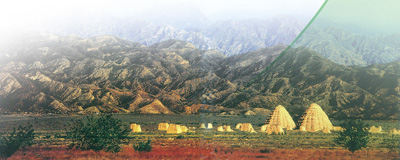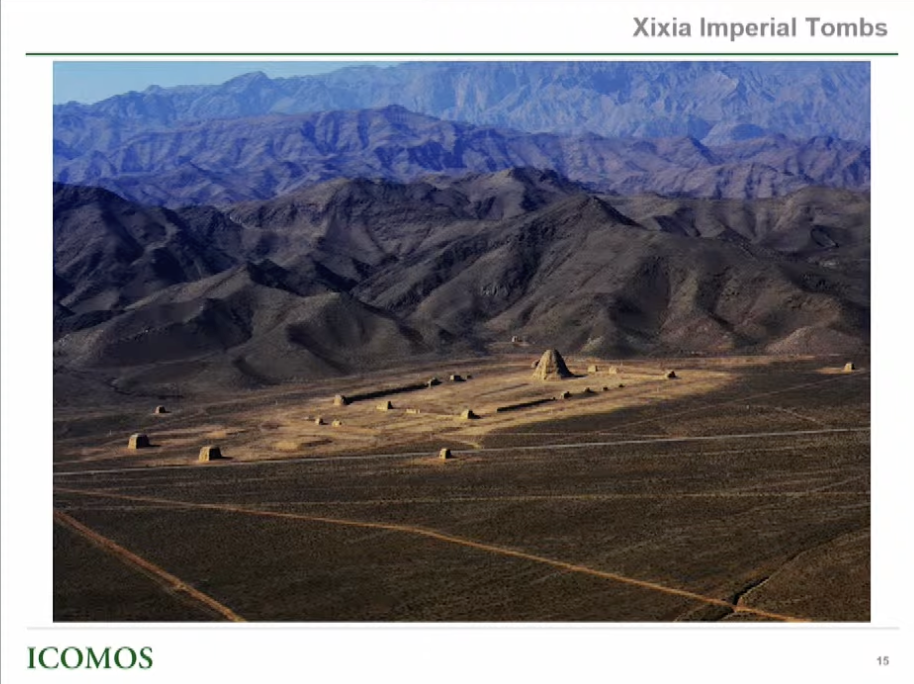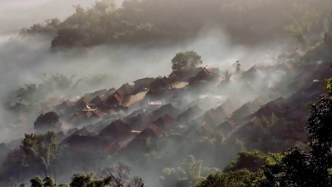

Western Xia Mausoleum. Photo courtesy of the Western Xia Mausoleum District Administration Office
This year marks the 40th anniversary of China's accession to the Convention Concerning the Protection of the World Cultural and Natural Heritage. From the first batch of heritage sites such as the Great Wall and the Forbidden City in Beijing being included in the World Heritage List in 1987 to the successful application of the Western Xia Tombs in 2025, the total number of Chinese World Heritage sites has reached 60, ranking first in the world.
These 40 years have been a process of continuous updating of China's world heritage protection concepts and deepening of its practices. Since the 18th CPC National Congress, the CPC Central Committee with Comrade Xi Jinping as its core has attached great importance to the protection, inheritance and utilization of cultural and natural heritage, and has promoted China's transition from a major world heritage country to a strong country in protection and management.
We invite experts, scholars and relevant practitioners to summarize the experience and inspiration of China's world heritage protection, inheritance and utilization. We look forward to more Chinese heritage going global and more Chinese experience benefiting the world in the future.
——Editor
host:
People's Daily reporter Wang Jue
Interview guests:
Liu Shuguang, Chairman of the China Museums Association
Zheng Jun, researcher at the Chinese Academy of Cultural Heritage
Director of Yinchuan Xixia Mausoleum District Management Office: Xiong Jun
Deeply explore the rich historical and cultural connotations of world heritage, tell the profound Chinese civilization, and promote exchanges and mutual learning among civilizations
Reporter: What experiences is worth sharing in my country's application for and protection of world heritage?
Zheng Jun: Over the past 40 years, China has ranked first in the world in terms of the number of world heritage sites, and the level of protection and management has been greatly improved. General Secretary Xi Jinping has made important instructions on strengthening the protection, inheritance and utilization of cultural and natural heritage. The Party and the government attach great importance to the application for world heritage status, creating a very good social environment and atmosphere. More and more people are paying attention to and supporting the application for world heritage status, and joining the team of protection, inheritance and utilization.
Liu Shuguang: The achievements China has made since joining the Convention Concerning the Protection of the World Cultural and Natural Heritage can be summarized into several aspects: first, a protection legal and planning system has been initially established; second, the protection management system has been gradually improved; third, the basic work of protection management has been further enhanced; fourth, the protection status has been comprehensively improved; fifth, the needs for display and interpretation have been basically met; and sixth, a very good role has been played in spreading the excellent Chinese culture and promoting international exchanges.
In particular, we have created a very practical and easy-to-use world cultural heritage monitoring system. Through data statistics, trend analysis, and information disclosure, the monitoring system provides objective and real data support for assessing the status of heritage protection and making protection decisions. Since its launch in 2014, it has played an important role in the declaration, protection, and international cooperation of world cultural heritage in my country, leading the world and being highly praised by international peers.
Through the protection and declaration of heritage, we have showcased Chinese civilization to the world, enhanced cultural confidence, promoted international cultural exchanges, and promoted exchanges and mutual learning among civilizations.
Xiong Jun: As a Chinese World Heritage Site in 2025, the Western Xia Tombs have achieved a breakthrough in Ningxia's World Cultural Heritage status. During the World Heritage Site application process, the Western Xia Tombs have continuously improved the management mechanism, management organization, team building, legal system, financial guarantee, archive management, and tourist services. They have continuously enriched their work in heritage monitoring, value interpretation, public participation, foreign exchanges, academic research, and cultural and tourism integration, and built a multi-level, multi-angle scientific protection and management system, accumulating experience.
The application for World Heritage status not only requires in-depth exploration of the rich historical and cultural connotations of the heritage, but also requires telling the story of Chinese history to the world, promoting exchanges and mutual learning among civilizations, expounding the spirit of the Chinese nation, building the image of a great civilized country, and comprehensively and vividly displaying the brilliant achievements of Chinese civilization and its important contributions to human civilization.
Promote the transformation of World Heritage from quantity leadership to quality leadership, and from single protection to comprehensive value
Reporter: How can we better promote the integration of world heritage into society?
Liu Shuguang: Heritage protection is not only a technical issue, but also a social proposition. We need to explore the sustainable development of China's world heritage. Sustainable development includes economic and environmental sustainability, but ultimately it must reflect the core of society - the all-round development of people. World heritage is also for the common interests of all mankind, for the spirit and culture of mankind, so it can be fully integrated with the goal of sustainable social development, and the essence of sustainable social development is closest to our original intention of protecting cultural and natural heritage.
Xiong Jun: During the application process for the World Heritage status, the Xixia Mausoleum paid attention to letting the public actively participate in heritage protection work and volunteer to carry out cultural relics safety protection and publicity. During the planning process, public opinions and suggestions were widely solicited through public channels. Surrounding residents also participated in the development of the Xixia Mausoleum tourism industry, which promoted the employment and income of residents and achieved the common development of the Xixia Mausoleum and local community residents. A series of colorful activities such as theme photography, calligraphy, children's painting, essay competitions, LOGO collection competitions, hiking, stargazing and camping were held, and activities were simultaneously promoted in communities, institutions, enterprises, schools, etc., aiming to deepen the public's understanding of the value of the Xixia Mausoleum heritage and increase the enthusiasm for participating in the protection and management of the Xixia Mausoleum.
Reporter: Do you have any suggestions on the application, protection, inheritance and utilization of world heritage?
Liu Shuguang: We should not forget the original intention of applying for World Heritage. We need to ask ourselves frequently: Is our original intention of applying for World Heritage still there?
We must protect precious heritage for all mankind, promote legislative and institutional reforms, explore new mechanisms to raise the level of heritage site management and expand national and provincial authorities, and solve the drawbacks of territorial management; strengthen capacity building and expert think tank construction, establish an interdisciplinary expert committee, strengthen talent training and monitoring system integration, and improve the scientific nature of decision-making and the accuracy of protection.
We must open our minds, uphold the truth and seek innovation, work hard, and protect, inherit and display Chinese civilization and history, show the world a real, three-dimensional and comprehensive China, and better promote exchanges and mutual learning among civilizations.
Zheng Jun: We need to correct our thoughts and political achievements in protecting world cultural heritage. Some local governments, in order to successfully apply for world heritage status, suspended some projects that undermined the value of world heritage during the application process. However, after the application was successful, they restarted these projects, regardless of the negative impact on the value of world heritage, and used the golden signboard of "world heritage" as a cash cow. World heritage is the common wealth of all mankind. When a heritage site is included in the World Heritage List, it means that the Chinese government and people have an additional responsibility to protect world heritage for all mankind. Successful application for world heritage status is a political achievement, and protecting world heritage is a greater political achievement.
In addition, we should use science and technology to enhance the protection of world heritage. With the rapid development of science and technology in my country, more advanced technologies can be applied to the protection of world heritage. my country has reached the world's leading level in ancient proteomics and ancient gene analysis, cave mural protection, earthen site reinforcement technology in arid areas, world heritage monitoring system and many other aspects. We should expand cooperation between industries and disciplines and apply more advanced scientific and technological means to the protection of world heritage.
In the face of the problems of focusing on application but not management, and focusing on utilization but not protection, it is necessary to balance the protection and utilization of world heritage
Reporter: What problems need to be solved in order to further strengthen and improve the protection, inheritance and utilization of world heritage?
Liu Shuguang: There are several key words for achieving high-quality development of world heritage sites. The first is to prioritize protection and management, the second is to enhance the connotation, and the third is to serve the public.
In terms of improving connotation, we still have a lot of work to do. Although China now has 60 world heritage sites, we did not fully understand the value of those world heritage sites that were applied for in the early years. The Great Wall is one of the first heritage sites in my country to be added to the World Heritage List. But when we applied for it, our understanding of the Great Wall was still quite limited. After so many years of work, we have conducted Great Wall resource surveys, implemented Great Wall protection projects, and built the Great Wall National Cultural Park. Our understanding of the value of the Great Wall is very different from when we applied for the World Heritage. For example, the value narrative at that time emphasized the symbol of suffering of the Great Wall. We now realize that the spiritual charm and ultimate value of the Great Wall is cultural integration, through "conflict", we finally see "integration". At present, many places regard their local Great Wall as a world heritage, but in fact many sections are not included in the heritage elements of the Great Wall World Cultural Heritage, and they are not protected, utilized and interpreted according to the standards of world heritage. These require us to do a better job.
Zheng Jun: At present, the biggest problems in the protection of world heritage are disaster prevention and mitigation and coping with climate change. According to statistics from the World Heritage Center, as of now, 103 world heritage sites in 62 countries have been affected by natural disasters such as earthquakes, typhoons, floods, landslides, biological diseases, etc., and 97 world heritage sites in 69 countries have been affected by climate change. The United Nations, UNESCO and the World Heritage Evaluation and Advisory Agency have all issued corresponding policies. China has done a lot of work, but there is still a lot of work to do.
World Heritage disaster prevention and mitigation and climate change response should focus on systematization, prevention and capacity building. Systematization means that disaster prevention and mitigation is a systematic project, which is composed of national and local governments and heritage sites, as well as meteorological, earthquake, fire, transportation, communication, electricity and other departments. Heritage sites should make full use of the power of the system, rather than fighting alone. Prevention means that heritage sites should strengthen the protection of cultural relics, improve the disaster resistance of cultural relics themselves, and prevent disasters outside the heritage sites by building preventive protection facilities; establish information sharing and linkage mechanisms with relevant departments, obtain disaster warning information in a timely manner, and prepare in advance; formulate and implement disaster prevention and climate change response plans; and focus on giving play to traditional wisdom.
Reporter: After successfully applying for world heritage status, some world heritage sites have problems of focusing more on application and less on management, and more on utilization and less on protection. How to balance the relationship between protection and utilization of world heritage?
Zheng Jun: To solve this problem, we need to realize that the utilization of world heritage can be divided into three levels:
The first level is to take the lead in the country, show Chinese culture to the outside world, strengthen cultural confidence internally, and build a strong sense of community for the Chinese nation. China's World Heritage carries the core values of Chinese civilization, such as the "Zhong" and "He" ideas contained in the Beijing Central Axis, the Confucian culture embodied in the Confucius Temple, and the concept of respecting heaven and following ancestors conveyed by the Temple of Heaven and Mount Tai, showing China's history, cultural orientation and the spiritual pursuit of the Chinese nation to the world.
The second level is the utilization of knowledge and skills. The scientific nature of the Dujiangyan water conservancy project, the artistry of the murals in the Mogao Grottoes in Dunhuang, and the planning paradigm of the Forbidden City can all become sources of scientific and technological innovation and artistic creation. Ancient towns, villages, and buildings can make the most of natural conditions to make the living environment healthier, safer, and more energy-efficient. Combining this theoretical knowledge with modern disciplines such as geography, geology, meteorology, architecture, and civil engineering to improve today's planning and design is the utilization of world heritage at the knowledge level. Cultural and creative development can also draw cultural essence from it and promote the development of new quality productivity.
The third level includes the use of tourism, residence, commerce and other activities, which directly involve the heritage entity. It is necessary to use it reasonably according to the value characteristics, type characteristics, preservation status, environmental conditions, etc. of the world heritage and avoid excessive use.
Protection and utilization are not contradictory, but complementary. We should strengthen the utilization of the first two levels, and strictly supervise the use of the third level to achieve the sustainable inheritance of heritage.
Liu Shuguang: China's world heritage sites are distributed over a vast area and are at different stages of local development. There are different challenges in terms of protection and utilization, but we have reached two consensuses. One is that "the purpose of applying for world heritage status is to better protect and utilize" and the other is "development through protection and protection through development."
After the successful application for World Heritage status, protection and value interpretation are still important tasks. Protection must follow the principle of combining international standards with China's reality. For example, the Grand Canal innovatively adopted the "serial heritage" application model when applying for World Heritage status, coordinated nearly 3,200 kilometers of river sections in 8 provinces, and established a national-led monitoring system. World Heritage protection is not a closed academic project, but an open social practice. Only by integrating into people's livelihood, empowering communities, and communicating with the world can a sustainable balance between protection and utilization be found.

